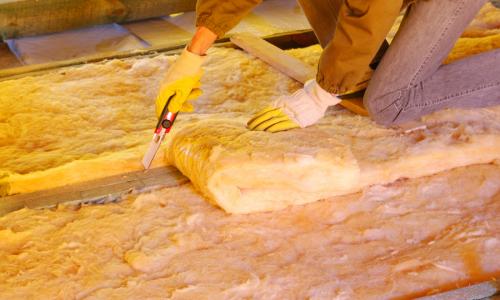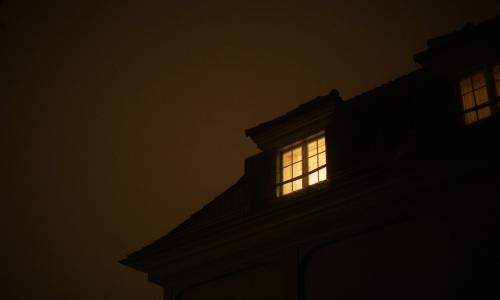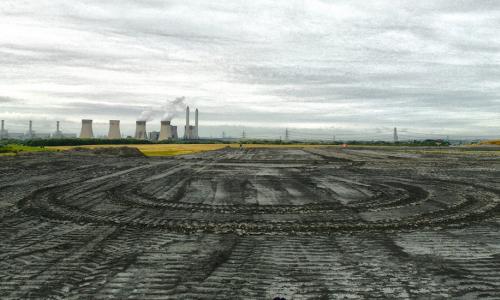Buildings account for about one-third of the energy consumed in the United States. Heating and cooling systems use 60 percent of this energy, while lights and appliances use another 40 percent. Manufacturing and transporting building materials requires additional energy.
By carefully applying design principles that capture natural breezes and the sun's energy and light, and by using solar water heating systems, energy use in buildings can be reduced dramatically. These renewable energy practices save money, result in more attractive buildings, and they improve the environment and strengthen the economy by reducing the need for fossil fuels.
What follows are some leading design considerations for environmentally responsible buildings and communities. We emphasize approaches that do not significantly alter the initial cost of a structure but that provide substantial long-term savings and a more comfortable living environment.
Passive solar design. Buildings constructed in the United States today are more energy efficient than ever before; their energy requirements can be much further reduced, however. Sunlight, landscaping, natural breezes, and the choice of building materials can all reduce the need to use and pay for fuel and electricity. Passive solar design—the use of a building's structure to capture sunlight and store heat—can alone save up to 50 percent or more of the energy used in a home.
Building orientation and window location. With little or no extra cost, a building can usually be oriented with its long face within at least 30 degrees of true South, creating energy savings without changing the design. (An orientation of within 15 degrees is optimal; within 30 degrees is acceptable.)
The next most important design feature is placing a high percentage of the building's windows on the south side. Conventional houses have about a quarter of their windows on the south side, and this generally averages about 3 percent of the house's total floor area. Ideally, the total area of south-facing windows should represent about 7 percent of the house's total floor space. Such a shift would allow the building to use more of the sun's energy by absorbing it into the materials of the house. This zero-cost option can save up to 25 percent of the house's conventional heating fuel and, with protection from a shading overhang, can help reduce summer cooling bills as well. In winter, when the sun arcs low in the sky, the south-facing glass will let in the sunshine to heat the space. In summer, when the sun is high in the sky, an overhang can prevent unwanted heat gain.
The total south-side window area could be expanded to up to 12 percent of floor area without overheating and without having to manage windows (opening and closing curtains), but this increase in window area requires a commensurate design feature for storing the additional heat, such as concrete or brick. In general, keeping such thermal storage uncovered and near the heated space increases its performance.
Additional low-cost passive design features. The interior layout of a building should allow for the natural flow of heat in the winter and for the enhancement of ventilation during the summer. Keeping the most lived-in spaces to the South, and storage spaces or garages as buffers to the North and West are common starting design features for new buildings.
The windows on the three nonsolar sides of a building must also be given careful attention. North-facing windows offer even light, but they also lose the most heat in winter. East and west windows, because of the low morning and evening sun, can produce the highest air-conditioning demands. West-facing windows transmit especially large amounts of heat on summer afternoons, and they can cause extensive overheating. Double-glazing should always be the norm, and high-efficiency, low-E coated glazing is almost always worth the extra cost.
To enhance passive cooling, a building's windows should be placed and designed to capture prevailing winds. A casement window that opens to the wind can allow breezes into the building; a window on the opposite side will allow stagnant air to be flushed out.
The use of breezes for cooling can be used in conjunction with the natural tendency of hot air to rise. With a high point designed in a building, the natural movement of hot air to the ceiling can be combined with an opening to the outside. This air movement is called "stack effect" and acts as a vent during the summer months. In parts of the country where the climate supports it, the same effect can be used at night to draw cool air into the building, replacing the heat built up during the day.
The color of building materials can also play an important role in helping passive design. In hot southern climates, for example, the roofs of buildings should be light colored to allow the sun's heat to be reflected rather than absorbed.
More complex design options. The addition of energy-absorbing thermal mass—material that stores and slowly releases heat—inside a house can help maximize its use of sunlight; slab floors are one zero- to low-cost thermal mass option. Any thermal mass option requires careful design to promote adequate distribution of the solar heat.
In addition, specific components can be designed into the building's shell or interior to capture and redistribute the heat from the sun's energy. Such features include glazed mass walls on the south side, and attached or integral "sunspaces"—isolated glazed rooms on the south side of the house where the solar energy is converted to heat and distributed by natural means to interior spaces.
Rooftops are important sites for electric energy resources for the future. Electric utilities in several parts of the country are currently analyzing the cost of renting rooftops for the placement of photovoltaic cells. These cells convert sunlight directly into electricity, and the systems may be tied directly into the utility grid. When the photovoltaic system produces more electricity than the house is using, that electricity flows back into the utility's wires, and it is purchased by the utility at a competitive rate. When the house requires more electricity than the photovoltaics can provide, it is purchased from the utility in conventional fashion.
Active systems. Active systems involve moving parts that circulate air through a building or move a liquid, most often water. Such systems may be used either in conjunction with passive design or as stand-alone heating or cooling systems. A fan, when combined with a passive system, is a common method to pull hot air to other locations in the building. Warm air is often brought to a low point in the building to create an assisted convective loop, helping to circulate air throughout the building. These systems may also be combined with thermal storage to further increase energy savings and comfort.
Roofs can also support active systems, such as solar water heaters. Today's water heating technology is far superior to the solar water heaters of the 1970s, and utility incentives for solar water heating are on the increase. The payback period for the heaters depends on the system, on the climatic conditions, and on local utility incentives. Possible future use of the roof for photovoltaics and solar water heaters represents an additional rationale for orienting roofs to the south.
Daylighting. Daylighting, or the use of natural light in a building, reduces the need for electric lights and improves the visual qualities of a space. It is one of the most rewarding design measures and is consistent with the heating and cooling aspects of passive design. Placing light-colored reflective surfaces close to windows will allow light to bounce farther into a room. Shades and blinds almost always enhance the ability to control the light.
It is possible for carefully controlled daylight to provide all of the necessary interior lighting with less heat emitted to the interior spaces than is released by incandescent or fluorescent lights. Because electric lights create an excess amount of internal heat, they can cause air conditioners to be on through much of the year. Open interior plans that enable natural light to penetrate to all parts of the structure, therefore, are especially important in commercial buildings, where electric lights are in the highest demand.
Additional conditions for environmentally responsible building
Environmentally responsible building cannot be achieved by design techniques alone. These techniques must be considered in conjunction with the overall healthfulness of the interior climate, the building's integrity, and the use of building materials that place the lowest demands on the environment. Ideally, buildings that incorporate these ideas will be located in communities that are also designed to maximize use of renewable energy resources.
Energy efficiency. Passive solar design must be combined with vigorous energy-efficiency measures: high levels of insulation, tight construction, and high-performance windows and doors. Going beyond the local building codes for insulation and for the energy performance of windows will always provide savings through the life of the building, thus increasing its value to the owner and to society.
Tight construction—taking care in construction to eliminate any possible penetration of air into the building envelope—is critical to energy performance. Combined with proper ventilation, it produces a building that is more comfortable because of the elimination of draft. The Energy Crafted Home project, for example, a Massachusetts program sponsored by local utilities, is encouraging such building techniques. It trains builders to build tight houses, then does a site test of each building for tightness.
Indoor air quality. The chemicals used in creating many building materials and furniture adversely affect indoor air quality. This issue is extremely important, since people spend 75 to 90 percent of their time indoors. Adverse health effects might range from sneezing or itchy eyes to lung cancer. The answer is not to build looser buildings, but to use healthy materials and to increase the amount of fresh air circulating through a building.
To maintain healthy indoor air quality in a tightly constructed house, at least half of the air must be replaced once each hour. To replace the air without losing the heat, energy-efficient exhaust air heat-recovery systems can be used, where applicable, and are readily available. Ducts in the main living spaces of the house allow fresh air to be circulated to where it is needed. An open interior plan allows air to move much more freely, in some cases eliminating the need for extensive ductwork.
Fortunately, for every unhealthy building material on the market, there are also healthy options available. Their availability and price depend on the demand of the building community.
Planning and landscaping. The street layout in new projects should provide building sites with unobstructed southern exposure. As a general rule, street layouts that run East-West accomplish this design objective. It is important that buildings, trees, or other obstructions do not block the sun at the most critical times of the year. The main objective is to allow the south side of a building as much unshaded exposure as possible during the winter months, most critically from about 9:00 am to about 3:00 pm. Some parts of the country have solar access laws and ordinances that protect the south side of buildings.
Landscaping can maximize the availability of renewable energy to a building. Deciduous trees, for example, can provide shade in summer and permit sunlight to strike the house directly in winter, but are still not recommended directly south of the structure. North-side evergreens can provide an effective windbreak and weather barrier.
A planning scheme with tree-lined, narrow streets decreases the amount of heat absorbed during the hot summer months. This results in a cooler microclimate, creating less need for mechanical cooling. In addition, fairly dense planting around houses can direct breezes for natural cooling, or block the cold north winds during the winter months.
The cost of energy-efficient construction
Many of the design features discussed here produce only very small cost increases, but more expensive changes can also make good financial sense for building buyers. By spending more money on the construction of the house, on good windows, and on more insulation, the mechanical system can be smaller, and the resulting energy bills will be smaller. In the long term, the life-cycle costs will be decreased, and the house will be more affordable to own. Every purchase should be evaluated in terms of multiyear energy cost savings.
Energy-efficient buildings often contain the esthetic features that are in demand today: natural light; an open, spacious feeling; fresh air; and less noise (as a result of smaller mechanical systems and greater wall insulation). In most cases, the marketing of such buildings does not have to focus on their use of renewable energy. Attractiveness, coupled with state-of-the-art energy-efficiency systems and style, can sell buildings.
Everyone benefits from energy-efficient construction. Energy-efficient buildings enable the banks and the builder to make money through the higher cost of construction, and the owner will save money through the decreased operation costs. While higher construction costs of renewable systems might result in larger mortgage payments, the increased efficiency will result in lower energy bills, and the two can balance each other out. In addition, some lenders are now offering "energy-efficient mortgages" to help home buyers with these increased costs.
Other energy considerations
Planning. Any land-use development should maximize public transportation possibilities by placing mixed types of housing in close proximity to businesses and commercial operations. Thoughtful planning can protect the natural environment and the community character by reducing the need for roadway expansion, and thereby decreasing the air pollutant emissions and conserving our limited energy resources.
Any development of buildings places an extra demand on local utilities. The natural resources that are affected, therefore, must be considered in planning, not just at the current costs, but at the costs the development will place on the community throughout its life.
Embodied energy. The construction of new buildings requires energy, and the building materials themselves embody energy. These materials have to be dug out of the ground, cut from the forest or field, or created by human technology. All these processes use energy. The distance that materials must be transported, and the intensive energy needed to prepare them for use in buildings, should be considered when choosing a material.
Construction materials should be durable, recyclable, or reusable. In virtually all cases, buying a durable product up front is more cost effective than buying a less-expensive, less-durable product. If something will last 50 years rather than 10 years, the payback is attractive in a life-cycle cost analysis. It will certainly place less demand on the amount of waste we create as society, which is a cost we all pay.
For further information
American Institute of Architects
1735 NY Avenue NW
Washington, DC 20006
202-626-7300
Environmental Resource Guide
American Solar Energy Society (ASES)
2400 Central Avenue, Unit G-1
Boulder, CO 80301
303-443-3130
Building Energy Technology Program
National Renewable Energy Laboratory (NREL)
1617 Cole Boulevard
Golden, CO 80401
303- 231-7303
Center for Resourceful Building Technology
PO Box 3413
Missoula, MT 59806
406-549-7678
Guide to Resource Efficient Building Elements
Conservation and Renewable Energy Inquiry and Referral Service (CAREIRS)
Renewable Energy Information
PO Box 8900
Silver Spring, MD 20907
800-523-2929
Energy Crafted Home
180 Lincoln Street
Boston, MA 02111
800- 628-8413
National Appropriate Technology Assistance Service (NATAS)
US Department of Energy
PO Box 2525
Butte, MT 27902-2525
800-428-2525
Passive Solar Industries Council (PSIC)
1511 K Street NW
Suite 600
Washington, DC 20005
202-628-7400
References
Hashem Akbari, et al., Cooling our Communities: A Guidebook on Tree Planting and Light-Colored Surfacing. Washington, DC: Environmental Protection Agency, EPA Document #055-000-00371-8, 1992.
John Bower, The Healthy House: How to Buy One, How to Build One, and How to Cure a Sick One. New York: Carol Publishing Group, 1989.
G.Z. Brown and V. Cartwright, Sun, Wind, and Light. New York: John Wiley & Sons, 1985.
David Pearson, The Natural House Book. New York: Fireside, 1989.
John Spears, Designing and Building Healthy Homes: A Guide for Home Builders. Baltimore, Md: Energy Conservation Management, Inc., 1992.
Andrew St. John, The Sourcebook for Sustainable Design, A Guide to Environmentally Responsible Building Materials and Processes. Boston: The Boston Society of Architects, 1992.
Steven J. Strong, The Solar Electric House: A Design Manual for Home-Scale Photovoltaic Power Systems. Emmaus, Penn.: Rodale Press, 1987.
Les Tumidaj, et al., Solar Access Design Manual, Office of Environmental Services, City of San Jose, Calif., 1992.
Brenda and Robert Vale, Green Architecture: Design for an Energy-Conscious Future. Boston: Bulfinch, 1991.
Sim Van der Ryn and Peter Calthorpe, Sustainable Communities: A New Design Synthesis for Cities, Suburbs, and Town. San Francisco: Sierra Club Books, 1991.




